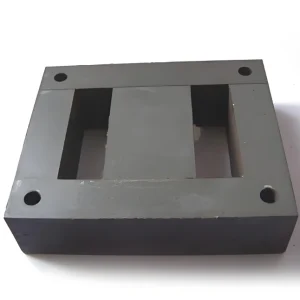
What is a Laminated Core?
Definition and Basic Concept
Laminated core of transformer is a core made up of thin layers of electrical steel. These layers are stacked together and insulated from one another. The primary purpose of this design is to reduce energy losses in transformers. Laminated cores are essential for efficient transformer operation.
Structure of the Laminated Core
The structure of a laminated core is designed to minimize energy losses and maximize efficiency.
1. Layers of Thin Steel Sheets
The core consists of multiple thin steel sheets. These sheets are typically made of silicon steel. The thinness of the sheets is crucial. It helps to reduce eddy current losses. The sheets are carefully aligned and stacked to form the core. This layering creates a path for magnetic flux with minimal resistance.
2. Insulation Between Layers
Each steel sheet is insulated from the others. The insulation is usually a thin coating of varnish or oxide. This insulation prevents electrical currents from flowing between the layers. By doing so, it further reduces eddy current losses. The insulation ensures that the magnetic flux flows efficiently through the core.
In summary, laminated core of transformer consists of thin steel sheets and insulation between layers. This structure helps to minimize energy losses and improve transformer efficiency.
Function of the Laminated Core
Reducing Eddy Current Losses
The laminated core significantly reduces eddy current losses. Eddy currents are circulating currents induced within the core material by the changing magnetic field. These currents generate heat and lead to energy loss. By using thin, insulated layers of steel, the laminated core restricts the flow of eddy currents. This design minimizes the area available for the currents to circulate, thereby reducing their magnitude and the associated losses.
Minimizing Hysteresis Losses
The laminated core of transformer also minimizes hysteresis losses. Hysteresis losses occur due to the repeated magnetization and demagnetization of the core material during each cycle of the alternating current. These losses are proportional to the area of the hysteresis loop of the core material. The steel used in laminated cores is chosen for its low hysteresis loss properties. Additionally, the thin layers help maintain consistent magnetization, reducing the energy lost in the form of heat.
Enhancing Magnetic Flux Efficiency
The design of the laminated core enhances magnetic flux efficiency. Magnetic flux refers to the flow of the magnetic field through the core. A well-laminated core ensures that the magnetic flux follows a defined path with minimal resistance. The thin steel layers, aligned correctly, provide an efficient route for the magnetic flux. This alignment reduces the reluctance (magnetic resistance) and ensures optimal performance of the transformer. Enhanced magnetic flux efficiency translates to better energy transfer and reduced operational losses.
In summary, the laminated core plays a crucial role in reducing eddy current losses, minimizing hysteresis losses, and enhancing magnetic flux efficiency. These functions are vital for the efficient and reliable operation of transformers.
Benefits of Laminated Core of Transformer
Improved Energy Efficiency
The laminated core significantly improves energy efficiency. By reducing eddy current and hysteresis losses, less energy is wasted as heat. This efficiency ensures that a higher percentage of electrical energy is transferred from the primary to the secondary winding. Improved energy efficiency leads to lower operational costs and better overall performance of the transformer.
Reduced Heat Generation
The design of the laminated core reduces heat generation. Eddy currents and hysteresis losses generate heat, which can damage the transformer over time. By minimizing these losses, the laminated core helps maintain a lower operating temperature. Reduced heat generation decreases the risk of overheating and prolongs the life of the transformer components.
Enhanced Transformer Lifespan
Laminated core of transformer also minimizes hysteresis losses. Hysteresis losses occur due to the repeated magnetization and demagnetization of the core material during each cycle of the alternating current. These losses are proportional to the area of the hysteresis loop of the core material. The steel used in laminated cores is chosen for its low hysteresis loss properties. Additionally, the thin layers help maintain consistent magnetization, reducing the energy lost in the form of heat.
Applications
Power Distribution Systems
Laminated core transformers are integral to power distribution systems. They step down the high voltage from power plants to lower levels suitable for residential and commercial use. The efficiency of laminated core transformers ensures minimal energy loss during this process. Their ability to operate reliably under varying loads makes them essential for maintaining stable power supply across the grid.
Industrial Machinery
In industrial settings, laminated core transformers are used to power machinery and equipment. They provide the necessary voltage transformation and ensure the smooth operation of industrial processes. The reduced heat generation and improved efficiency of laminated core transformers make them ideal for heavy-duty applications, where consistent and reliable power is crucial. Their durability and long lifespan also mean less downtime and lower maintenance costs for industrial facilities.